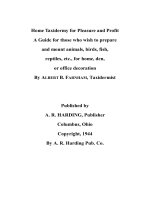Equipment for moving and handling people potx
Bạn đang xem bản rút gọn của tài liệu. Xem và tải ngay bản đầy đủ của tài liệu tại đây (4.36 MB, 34 trang )
191
section 7
Contents
• Usingequipmentformovingandhandlingpeople
• Typesofequipment
• Examplesofmovingandhandlingequipment
– Slidesheets
– Transferbelts
– Transferboards
– Air‑assistedtransferdevices
– Electricprofilingbeds
– Mobilehoists
– Standinghoists
– Ceilinghoists
– Gantryhoists
– Fixedwallhoists
– Slings
– Stretchers
– Wheelchairs
– Standingandpivotingaids
(non‑electric)
– Showerandbathequipment
– Emergencyequipment
– Othertypesofequipment
andaids
• Referencesandresources.
Note:Allimagesandotherreferencestoequipmentshowninthissectionare
providedforillustrativepurposesonly.Theyarenot,andshouldnotbetakenas,
endorsementsofspecificequipmentorsuppliers.
Equipment for moving and handling people
192
7.1 Using equipment for moving and handling people
Thissectiondescribesthemaintypesandfunctionsofequipmentformovingand
handlingpeople.Section8oftheGuidelines,‘Equipmentmanagement’,covers
equipmentprocurementsystems,maintaininganequipmentregisterandequipment
storage,maintenanceandreplacement.
Equipmentisacorecomponentineffectivemovingandhandlingprogrammes,
togetherwithriskassessments,theuseofcorrecttechniques,stafftrainingand
appropriatefacilitydesign.Thesupplyofequipmentbyitselfwillnotleadtoreduced
ratesofinjuryunlessequipmentuseispartofacomprehensivemovingandhandling
programme.Successfulprogrammesprovidebothequipmentandtraininginhowto
usespecificitemsofequipmentforlifting,transferringandrepositioningclients.
Theproperuseofequipmentisessentialforthesafetyofbothclientsandcarersand
improvesthequalityofclientcare.Equipmentcanalsofacilitateclientrehabilitation,
decreasemorbidityandpreservethedignityofclients.Comparedwithtechniques
thatinvolvemanualtransfersofclientswithoutequipment,theuseofequipment
lessenstheforcesrequiredformovingandhandlingclientsandcanreducetherisks.
Movingandhandlingequipmentalsoimprovesclientoutcomes,suchasreducing
theirlengthofstayandtheriskofcomplicationssuchasdeepveinthrombosis,chest
infections,urinarytractinfections,pressureulcers,skintearsandfalls.
Having‘fit‑for‑purpose’equipmentisoneofthemostimportantaspectsofmoving
andhandlingprogrammes.Newmovingandhandlingequipmentisconstantly
beingdeveloped.Withtheincreasingcomplexityofequipmentandtechnological
developments,informationaboutspecificequipmentcanbecomeoutdated.
Managersresponsibleforpurchasingequipment,andpeopleprovidingtraining
inequipmentuse,needtokeepuptodatewithdevelopmentsinequipmentfor
movingandhandlingpeople.Theprimaryfocusofthissectionisondescriptionsof
equipmentandspecificfeatures.Specificproceduresforusingequipment,suchas
slidesheets,slingsandhoists,aredescribedinSection4Techniquesformovingand
handlingpeople.
193
Section 7: equipment for moving and handling people
7.2 Types of equipment
Table7.1showsthemaintypesofequipmentusedformovingpeople,andexamples
ofcommonuses.Sometypesofequipmentareknownbyseveralnames,asshown.
Detaileddescriptionsofeachtypeofequipmentareprovidedlaterinthissection.
Forsomecategoriesofequipment,thereareseveralrelatedtypes,whichmayhave
differentnames.
Table 7.1 Common types of equipment
Type of equipment
(and alternative names) Description and common uses
Slide sheet
(slidingsheet,slipperysam)
Asheetmadeoflow‑frictionmaterialandusedunderaclient
toalloweasyrepositioninginbed,slingattachmentand
lateraltransfers
Transfer belt
(handlingbelt,gaitbelt,
walkingbelt)
Abeltplacedaroundaclient’swaistduringseveraltypesof
transferandforassistedwalkingforrehabilitation.Thereare
multipletypesofbelt
Transfer board
(PATslide,slideboard,
bananaboard)
Afull‑body‑lengthboardmadefromwoodorplastic,usedto
bridgegapsforclienttransfersfromonesurfacetoanother,
suchasfromastretcherorwheelchairtoabed.Smallertransfer
boardscanalsobeusedforlateral,seated‑to‑seatedtransfers
Air‑assisted transfer device
Thereareseveraltypes:inflatablemattressesforlateral
(bed‑to‑bed)transfersandair‑assistedliftingdevicesor‘jacks’
Electric profiling bed
(electricbed)
Anelectricallyoperatedbedthathasamattressplatformsplit
intotwo,threeorfoursections,whichallowsadjustmentusing
acontrolhandsetorpanel
Mobile hoist
(floorhoist,floorlift,mechanical
lift,portablehoist)
Ahoistwithwheelsthatcanbemovedalongthefloor–used
forliftingaclientinsideaslingoronastretcherdesignedforuse
withhoists
Standing hoist
(sittostandhoist,standinglift,
stand‑aidhoist)
Aspecifictypeofmobilehoistdesignedtoassistpeoplebetween
sittingandstandingpositions.Standinghoistsaredesignedto
fitunderandaroundchairs
Ceiling hoist
(overheadhoist,ceilinglift,
mechanicallift,gantryhoist)
Ahoistattachedtopermanentlymountedceilingtrackthat
movesaclientinsideasling.Gantryhoistshaveoverheadtracks
mountedonwheeledframes
Sling
Afabricsupportusedforcarryingaclientwhilebeingmoved
withahoist–therearemultipletypesofsling
Stretcher
Arigidframeusedtocarryaclientinalyingorsupineposition.
Oftenmadeoflightweightmaterialandcommonlyusedin
ambulancesandbyemergencyservices.Wheeledstretchersare
usedinhospitalsfortransportingclientsbetweenlocations,and
shouldbeelectric
Wheelchair
Amobilechairusedfortransportingaclientinasittingor
uprightposition.Bariatricwheelchairsmustbepoweredor
movedwithbedpushers
194
Themaintypesofequipmentthatarecommonlyusedcanbesummarisedwithinthe
fourmaingroupsofclientmovingandhandlingtasks.Thesegroupsoftasksare:
• Sitting,standingandwalking
• Bedmobility
• Lateraltransfers
• Hoisting.
Table7.2providesasummaryofthecommontypesofequipmentusedforthese
handlingtasks.Therecommendedtechniquesforeachoftasksinthetablebeloware
describedinSection5oftheGuidelines.
Table 7.2 Handling tasks for which equipment may be used
Type of task
Examples of specific
movements
Examples of equipment that could
beused
Sitting,standingand
walking
Sittingtostandingfrom
achair
Transferbelt,standinghoist,mobilehoist,
chair‑lifter
Standingtosittingonabed Transferbelt
Assistedwalking Transferbelt,walker,gutterframe,hoist
withwalkingharness
Bedmobility Turninginbed Slidesheets,electricbedwith
turningfunction
Slidingclientupinbed Slidesheets,electricbed
Sittingpersonupontoedge
ofbed
Slidesheets,electricbed,bedaccessories
Lateraltransfers Lateraltransferfrombed
tostretcher
Slidesheets,transferboard,airmattress,
standinghoist
Transferringfromchair
tocommode
Ceilinghoist,mobilehoist,seatedtransfer
board,standinghoist
Transferringtotoilet Ceilinghoist,mobilehoist
Hoisting Fittingaslingtoclientinbed Sling
Hoistingfrombedtochair Ceilinghoist,mobilehoist,standinghoist
Hoistingclientfromfloor Ceilinghoist,mobilehoist,airjack
Transferringtotoilet Ceilinghoist,mobilehoist,standinghoist
195
Section 7: equipment for moving and handling people
7.3 Examples of moving and handling equipment
Thenextpartofthissectionprovidesexamplesofthemorecommonlyusedtypesof
equipmentforclienthandling.Furtherinformationaboutspecifictypesandfunctions
ofequipmentcanbeobtainedfromthewebsitesshownattheendofthissection,
andfromcompaniessupplyinghealthcareequipmentinNewZealandandAustralia.
Traininginproperuseisessentialforalltypesofequipment.
Slide sheets
Slidesheetsareoneofthemostcommonly
usedtypesofequipmentinhealthcare
services.Theyareusedtomoveclients
horizontallyonbeds,trolleysandchairs
withoutlifting.Slidesheetsarerelatively
lowcost,havemanyusesandarerelatively
simpletouse.Theyavoidtheneedtolift
clients,butdespitetheirsimplicitytheydo
requiretrainingintheirproperuse.
Itisimportantthattheuseofslidesheets
isconsistentwithcurrentbestpractice,
asdescribedinSection4Techniquesformovingandhandlingpeople.Trainingis
necessaryinthecorrectapplicationanduseofslidesheets.Incorrectusecancause
injurytobothcarersandclients.Slidesheetsaremadefromlightweightfabricand
havelow‑frictionsurfacesthatbecomeveryslipperywhenplacedtogether.They
comeindifferentconfigurations:thefabricmaybesewntogethertomakeadouble
sheet,ortheymaycomeassinglesheetsthatthecarerfoldsovertoformadouble
layer.Twosheetscanalsobeusedtogether.Theymayormaynothavehandlesfor
hangingup.Twosinglesheetsarepreferableastheyaremultidirectionalandallow
optimalmovement.
Thereareseveralhandlingtechniquesthatuseslidesheets(seeSection4Techniques
formovingandhandlingpeople).Usingthemunderneathapersonallowsan
independentorassistedslidingmovementonabed.Theycanbeusedformanytasks
involvinglateraltransfersandrepositioning,suchas:
• Movingaclientinbed
• Turningaclientontotheirsideinbed
• Transferringaclientfromabedtoabedwithatransferboard
• Foraclientwhohasfallenintoaconfinedspace;slidesheetscanbeusedto
movetheclientalongthefloortoalocationwhereahoistcanbeused
• Facilitatingindependentbedmobility.
Slidesheetscomeindifferentsizesandtheymaybepaddedorunpadded.Slide
sheetswithloopscanbestoredonhooksbesideclients’beds.
Slide sheets
figure 7.1
196
Points to note about slide sheets
• Alwaysconductariskassessmentpriortomovingaclient
• Mostslidesheettransfersrequiretwocarers
• Theriskassessmentshouldincludeskinintegrity,pressureareas,wounds,
attachmentsandsensitivities
• Assesspainmanagement
• Encouragemobilitywherepossible
• Whenmovinglargeclients,ensurethereisasufficientnumberofcorrectly
sizedslidesheetsandenoughstaffforthetransfer
• Infectioncontrolconsiderationsrequireslidesheetusewithoneclientonly
beforebeinglaundered
• Slidesheetsshouldbeaccessible
besidethebedoftheclientforwhom
theyarerequired–asuitablestorage
facilityisneeded,suchasahook,
containerorfabricholdingbag
• Whenaclientisdischargedormoved
toanotherlocation,orthesheets
becomesoiled,theslidesheets
shouldbesentforlaundering
• Bed‑to‑bedtransfersshouldalways
usebothslidesheetsandatransferboard
• Mosttypesofslidesheetaredesignedtobelaundered(seeSection8,
Table8.2).Theusualslidesheetlifespanisaround80washes,dependingon
thequality
• Slidesheetsmustbeinspectedfortearsandotherdamagebeforeuse.
Slidesheetscanbeusedmultipletimesonthesameclientandrequirelaundering
whensoiled,orbeforeusingwithadifferentclient.Organisationsneedtohavea
systemforlaunderingslidesheetsseparatelyfromregularlaundry,asahotwash
destroysthefabric,reducingthelifespanoftheslidesheet.Slidesheetcareshouldbe
outlinedintheorganisation’smovingandhandlingpolicy.Therearealsodisposable
slidesheetsforsingleclientuseonly,whicharediscardedwhennolongerneededfor
thatclient.
Transfer belts
Transferbeltsarefastenedaroundclients’waistsortrunksduringtransfersandfor
assistedwalking.Theyareprimarilyforclientswhoaremobile.Themainfunctionof
transferbeltsistoassistalmostindependentclientsinmobilising.Theycanalso
Store slide sheets beside bed
figure 7.2
197
Section 7: equipment for moving and handling people
assistwithclientswhomightbedifficulttohold,eitherbecauseofsize,ordiscomfort
(malewalkingfemale)orbecausetheclientisuncomfortablewithbeingassisted.The
beltscanprovideanextralayerbetweencarersandclients.Beltsdesignedspecifically
toassistclientswhenwalkingaresometimesreferredtoas‘gaitbelts’.
Transferbeltsareusedtoassistthe
developmentofmobilityandrehabilitation
forclientswhoareminimallydependent,
haveweight‑bearingcapacityand
arecooperative.Typesofuseinclude
bed‑to‑chair,chair‑to‑chairandchair‑to‑car
transfers,repositioningclientsinchairs,and
supportingclientswhilewalking.
Therearemultipletypesofbelt.Mostbelts
aremadeoffabricorcushionedmaterial
andhavemultipleloopsorhandholds.
Thebeltsaresecuredaroundclients’waistsandadjusteduntiltheyarefirm,not
tight.Transferbeltsshouldonlybewornbyclients,neverbycarers.
Points to note about transfer belts
Therearesomerisksforcarersassociatedwithusingtransferbelts.Forthisreason,
somemovingandhandlingcoordinatorsrecommendthattransferbeltsnotbeused
forclienttransfers.Ifused,thecarershouldholdontothehandlesfromtheoutside,
andneverputtheirthumbsinsideorthroughtheloops(incasetheclientfallsand
thecarercannotdisengagetheirhands).Transferbeltsshouldneverbeusedto
liftclients.
Transfer boards
Therearemultipletypesoftransfer
boardandrelatedassistivedevices.
Full‑body‑lengthtransferboards
(sometimeslabelledasPATslidesor
TransglidesinNewZealand)areusedto
bridgegapsforclientswhoarelyingdown
whenslidingbetweentwoadjacentsurfaces
atsimilarlevels,suchasfromabedtoa
stretcher.Theyareusuallymadeofplastic
andshouldbeusedinconjunctionwithslide
sheets.Smallertransferboardscanbeused
forseat‑to‑seattransfers,suchasbetweenacarseatandawheelchair.
Inthepast,rollerboardshavebeenusedaslying‑to‑lyingtransferdevices.These
boardshavealoosevinylcoveringthatisdifficulttocleanandpotentiallyaninfection
Transfer belt
figure 7.3
Full‑length transfer board
figure 7.4
198
controlrisk.Theseboardscreaterisksforcarerswhenreachingandrisksforclients
withskinshear.Itisrecommendedthatrollerboardsbereplacedwithfull‑length
transferboards.
Sitting‑to‑sitting transfers
Forsitting‑to‑sittinglateraltransfers,a
smallertransferboardorslideboardcanbe
usedtobridgegapsbetweenadjacentseats.
Theseboardscanbestraightorcurvedlike
aboomerang(anexampleistheyellow
‘bananaboard’).Smalltransferorslide
boardscanbeusedforlateraltransferssuch
asthosebetweena:
• Chairandwheelchair
• Bedandwheelchair
• Wheelchairandtoilet
• Wheelchairandcar.
Curvedtransferboardsmakeiteasiertotransferaroundfixedarmrests.Theboards
areusuallyprescribedbytherapists.Notethatclientsshouldhavesittingbalanceto
usetheseboardsandbothcarersandclientsrequiretrainingintheiruse.Iffeasible,
arrangetohavethesurfacetowhichtheclientisbeingtransferredslightlylowerthan
thesurfacefromwhichtheyarebeingtransferred.Thismakesiteasierfortheclient
tomove.
Air‑assisted transfer devices
Thereareanumberofair‑assistedtransfer
devicesavailable.Therearetwogeneral
types:inflatablemattressesforlateral
(e.g.bedtobed)transfersandair‑assisted
liftingdevices,or‘jacks’.Thesedevices
aregenerallyversatileandcosteffective,
especiallyforsmallfacilities.
Inflatable mattresses
Forlateraltransferswhilelyingdown:the
clientliesonthemattresswhiletheclient
andmattressaretransferredbetweentwoadjacentsurfaces,andair‑assistedlifting
devices.Alateraltransferairmattresscanbeusedasanalternativetoatransfer
boardandslidesheets.Themattressesareeffectiveforreducingfriction,andthusthe
loadoncarersduringlateraltransfers.
Sitting transfer board
figure 7.5
Air‑assisted mattress
figure 7.6
199
Section 7: equipment for moving and handling people
Air jacks
Air‑assistedliftingdevices,or‘jacks’,canbeusedtoraiseclientsfromthefloorto
bedorstretcherlevelbypumpingairintoanairmattresswithmultiplelayers,which
expandverticallyasmoreairispumpedin.Thejackscanbeveryusefulforlifting
fallenclientsfromthefloor.Figure7.7showsanexampleofanairjackthatliftsclients
inasittingposition.Figure7.8showsa‘Hoverjack’thatliftsclientsinalyingposition
fromthefloortobedheight.Alltypesofair‑assisteddevicerequirecarerstosteady
theclient,andanairpump.
figure 7.7
Air‑assisted jack
figure 7.8
Air‑assisted ‘Hoverjack’
Electric profiling beds
Anelectricprofilingbedhasamattress
platformcomprisingtwo,threeorfour
separatesections,eachofwhichcan
beadjustedusingacontrolhandsetor
panel.Heightadjustmentallowsthebed
toberaisedorloweredquicklyforclient
movementsandclinicalservices.
Someelectricbedshaveonemovable
sectioninwhichonlytheheadorbackrest
sectioncanberaised,allowingaclienttosit
upinbed.Withthesebeds,clientsaremore
likelytoslidedownthebedsandmayneedfrequenthelpfromcarers.
Example of an electric bed
figure 7.9
200
Figure 7.10
Electric bed showing profile positions
Thegeneralbenefitsofelectricbedsare:
• Promotionofclientmobilityandindependence
• Reducedworkloadforstaff
• Reductioninmanualhandlingrisksandinjuriestostaff
• Reducedincidenceofpressuresoresinclients.
Withelectricbeds,staffcanadjusttheheightmoreaccuratelytosuitindividualclient
andcarerneeds.Beingabletostandbackandobserveaclientwhileoperatingabed
allowsstafftoobservetheclientmovingintodifferentpositions.Improvedclient
comfortismorelikelyasadjustmentsofthebedsareusuallysmootherthanwithbeds
requiringahydraulicpumpingaction.
Allclinicalareasandclientsbenefitfromthebedheightadjustmentthatallowslow
bedheights.Electricbedsalsofacilitateclientsgettingoutofbedbyraisingthem
closertoastandingposition.Stafftimecanbesavedbythereducedneedformanual
handlingofclientsandtheremovalofhydraulicpumpingonnon‑electricbeds.
Points to note about electric beds
• Mattress compatibility:
Someelectricbedsmay
requirespecialsectioned
mattresses.Bedsrequiring
specialmattressesmay
meanreplacingbedsas
acombinedbedand
mattressprocurement
• Size:Electricbedscan
belarge.Bedswitha
longer‑than‑averagelength
mayleadtoreducedspace
inareassuchasmulti‑bed
units.Theycanbedifficult
Box 7.1
Compatibility of electric beds and
mobilehoists
A common problem I have come across is the
incompatibility of some cheaper electric beds
with mobile hoists. The beds do not allow
clear access underneath for the hoist legs to
go under. Staff have to push and pull resulting
in jerky movements for the resident. There was
an incident where electric bed wires under the
bed caused an accident when the hoist was
pulled over the wires and the patient fell out
of the sling. Manufacturers need to provide a
way of hooking up the wires out of the way.
Source: Manual handling trainer
201
Section 7: equipment for moving and handling people
tomanoeuvreintightcornersandnarrowcorridorsandthroughdoorwaysand
hospitallifts
• Compatibility with other equipment:Mobilehoistsusuallyneed
positioningunderbeds.Canthesuppliedmobilehoistsfitunderthebedatits
lowestsetting?
• Weight and portability:Theportabilityofelectricbedsisaconsideration
forcommunityuseowingtotheneedtotransportthebedsandassemble
theminclients’homesandotherresidentialsettings.Inhospitals,bedsmay
needtobemovedfromwardtoward.Beingabletomoveandsteerbedsmay
beaconsideration.Theheavyweightofmanyelectricbedsmaybeanissue
whenbedsareusedtotransportclientsthroughcarpetedareasorupsloping
corridors.Amechanicalbedpushercanbeusedtoassistwithmobilityof
thebeds
• Installing new beds:Whenevernewequipmentispurchased,planforall
relevantcarerstobetrainedinitsuse.Bedsarebecomingmorecomplexand
allpracticablestepsshouldbetakentoensuretheirsafeuse.
Specific features
Electricbedscomeinmanyshapesandsizes.Theycanincludemanyfeaturesthatare
notapparentonabriefinspection.Somepotentiallyusefulfeaturesaredescribed
below.
1
Whenpurchasingelectricbeds,theassessmentandprocurementprocedures
needtotakeintoaccountthetypesofclientthatwillbeusingthebedsandthebed
featuresthatwillmostoftenbeusedbycarers.
• Minimum height:Somemodels
ofbedarequitehighwhenintheir
lowestpositionsforsmallclients.
Shortclientscanfinditdifficultto
placetheirfeetonthefloorwhen
transferringoffandontothebed
edge,reducingtheirindependence.
Asimilarproblemcanoccurwith
theuseofpressure‑reducingoverlay
mattresses,astheheightincrease
cancausetransferdifficultiesfor
someclients.Someelectricbedsare
designedtogodownclosetofloorlevel(sometimesreferredtoas‘floorline’
beds)andcanbeusedinfallsmanagement
• Number of sections:Bedswithfoursectionsaremostversatileforpositioning
clients.However,bedswithtwoorthreesectionsareavailable
1. SomeofthepointsinthissectionarefromthereportbyMHRA,2003.
Example of an electric bed that can
lower close to floor level
figure 7.11
202
• Bed‑to‑seat or bed‑to‑stand profiling:Somemodelsofelectricbedallowthe
profileofthebedtoconverttoaseatortoastandingpositionwhiletheclient
isinthebed.Thisavoidstheneedforcarerstofitslingsonclientswhoare
lyingdown,ormanuallyrepositioningclientsfromlyingtosittingandsittingto
standing
• Side rails:Railsatthesideofthe
bedthatcanberaisedorlowered
preventclientsrollingoutofbed.
Theminimumheighttowhichbeds
canbeloweredmaybecompromised
bytheuseofsiderails,particularly
drop‑downrailsandthosethatfold
underneaththebed.Siderailsneed
tobeadjustabletoallowtransfers
betweenbedandstretcher.Siderails
arearecognisedformofrestraint,
andifbeingusedforrestraintneedtobenotedintherestraintregister,
consistentwithorganisationpolicy.Splitrailsarepreferableandseenlessas
arestraint
• Turning function:Somebedshaveturningfunctionsthatallowclientstobe
turnedontheirsides.Dependingonthetypeofbed,turningcanbeactivated
bytheclientinbedorbyacarer,orthebedcanbeprogrammedtoturnatset
intervals.Cautionmustbeusedwithturningfunctionsasthereisthepotential
forlimbstobetrapped,particularlywithclientswhohavedecreasedsensation
orcommunicationdifficulties.Mechanicalturningdoesnotreplacetheother
functionsofcarer‑providedturningofaclient,suchascheckingbreathingand
skinandprovidinghumancontact
• Battery backup:Beingabletooperatebedsonbackupbatteriesmaybe
neededwhereclientsaremovedbetweenlocationsinbed,orwhereaccessto
electricalsocketsislimited
• Manual operation:Isthereprovisionformanualoperationincaseofbattery
orelectricalfailure?Themanualleversneedtobeidentifiedeasilybystaff
• Cleaning and infection control:Thecomponentareaoftheelectricbedframe
andanyattachmentsshouldbeaccessibleforcleaning.Easeofcleaningisbest
assessedwhentriallingabed
• Preventing client moving down the bed:Clientsoftenmovedowntheir
bedswhenmovedfromlyingtosittingpositions.Onelectricbeds,thismay
occurasthebedsareprofiledtoliftupclients’heads.Thiscanbeavoided
ifthebedsincludeafeaturecalled‘auto‑regression’ofthebackrestsinthe
bedspecification
Side rails on a bed
figure 7.12
203
Section 7: equipment for moving and handling people
• Lockout facility:Afacilitytolocktheadjustmentstopreventbedsbeing
profiledortiltedmaybeimportantinclinicalareaswhereitisnecessaryto
preventkneeflexionorothermovementsinclientswhoneedtobenursedflat.
Thelock‑outfeaturemayalsobeusefulduringvisitingtimestoavoidmishaps
associatedwithvisitors
• Wheel locks:Locksonbedwheels
areusedtopreventbedsbeing
moved.Theseareimportant
forsometypesoftransfer,such
asbed‑to‑bedtransfersusing
transferboards
• Handsets:Twofeaturesofthe
controlhandsetstoassessare
therobustnessofthehandsets
andcontrolpanels,andtheirease
ofoperation
• Other features:Thereareanumberofotherspecialistoperationsand
functionsavailableonsomeelectricbeds.Theseincludeweighingscalesbuilt
intothebeds,motorisedbedsthatassistmovementalongcorridors,and
anti‑fallalarms.
Bed accessories
Therearemultipleaccessories,oradd‑ons,forbedsthatcanbeusefulforsometypes
ofclientandsetting,especiallyincommunitysettingswhereelectricbedsarenot
available.Theseinclude:
• Bed ladders:Smallladdersorstepsplacedatthesidesorendsofbedsthat
allowpartiallymobileclientstogetinandoutofbed
• Bed or hand blocks:Handblockshavewidebasesandhandholds.Theyare
usedinpairsbyclientswhoaresittinginbed
• Bed levers:Abedleverisagrabrailthataclientcanusetohelpthemsitup
orturnoverinbed.Therearevarioustypesandtheycanbefixedtothewall,
bedorfloor.Somemayobstructpartofthebedside,makingitdifficultforthe
clienttogetinandoutofbed,whileothersareadjustableandcanbemoved
awayfromthebed.Bed‑fixedleversmustbesecurelypositionedandfittedto
besafeforuse.Somebed‑fixedlevershaveplatformsorrailsthatgounderthe
mattresses,sotheyaresecuredinpositionbytheclients’bodyweight
• Rope ladders:Aropeladderhelpstheclienttopullthemselvesupinbedfrom
alyingpositiontoasittingposition.Ithasplasticorwoodenrungslinked
togetherwithropetoformaladder.Theladderattachestothefootorbaseof
thebed.Ropeladdersareunstabletopulluponandoftenneedpracticeto
master.Clientsneedtohavestrongupperlimbsandabdominalmuscles.Itis
Wheel locks on a bed
figure 7.13
204
essentialthattheropeladderissecurelyfixedtothebedandtheclientcan
reachthefirstrungwhentheyarelyingonthebed.Ropeladderswithplastic
rungsmaybeslipperytohold
• Overhead poles:Overheador
liftingpoles(sometimescalled
‘monkeypoles’)areusedbyclients
tomoveinbed,suchasupand
downthebedandinandoutof
thebed.Theycanalsobeusedby
clientstoliftthemselvessothat
bedpanscanbeplacedunderthem.
Mostoverheadpolesusefloor‑or
bed‑mountedcantilevergantries,
withhandleshangingfromthem
onheight‑adjustablestraps.Thegantryframesmustbesecuredtostop
themtipping.Allpolesshouldhavesafeworkingloads(SWLs)clearlymarked
onthem
• Bed lifters:Theseareusedtoliftbedstosuitableworkingheightssothat
carersdonothavetostoop.Theyaresuitablefornon‑electricbeds,suchasin
homeswheretheyallowclientstocontinueusingtheirownbeds.Theydonot
provideprofilingactions,andtheyrequiresufficientspacetogetunder
thebeds
• Bed movers:Thesebattery‑operated
devices(seeFigure7.15)attachunder
thefootendsofbedsandallow
operatorstotransportbedsand
clientstootherlocations.Theyhave
controlsthatallowmanoeuvringin
confinedspacesandsteeringalong
corridors.Theirpositioningallows
theoperatorstoseetheclients
duringuse.Bedmoversreducestrain
onstaffwhoregularlymovebeds
duringtheirworkshifts.However,theyincreasetheoveralllengthofthebeds
andmaynotfitinlifts.Bedmoversrequireadditionalstorageanditmaybe
difficulttohavemoverskeptwhereneeded.
Overhead pole
figure 7.14
Bed mover
figure 7.15
205
Section 7: equipment for moving and handling people
Hoists
Therearethreegeneralcategoriesofhoist:mobilefloorhoists,standinghoistsand
ceilinghoists(sometimescalledoverheadhoists).Insomecountrieshoistsarecalled
liftsormechanicallifts.Allhoistsuseslingstoholdclients,andsomehoistscan
liftclientsinspeciallydesignedstretchers.Allhoistsshouldbecompliantwiththe
StandardsNewZealandrequirementsinAS/NZS3551:2004Technicalmanagement
programsformedicaldevices.Thisstandardcoversprocurement,acceptanceprocess,
safetyandperformancetestinganddisposal.
Thetypesofslingusedwithhoistsaredescribedlaterinthissection.Allhoists,slings
andceilingtrackingshouldbeclearlylabelledwiththeirSWLs.
Allcarersusinghoistsshouldbetrainedinfittingslingsandintheproperuseofhoists
priortousingthem.Carersalsoneedtobefamiliarwiththespecificfunctionsof
particulartypesormodelsofhoist.Likeothermovingandhandlingequipment,hoist
designsandfeaturesarecontinuallyevolving.
Mobile hoists
Mobilehoists(sometimescalledmobilefloorhoists)areusedtotransferclients
whoarenotmobilebetweenlocations,suchasfromabedtoachairorabathroom.
Theycanalsoassistwithambulation,gaittrainingandotherspecialisedfunctions.
Theclientissupportedinahoistsling,whichshouldbesingle‑clientassignedfor
infectioncontrol.
Mobilehoistscanbeverycosteffective,astheycanbemovedtodifferentlocations
inafacility.Onehoistcanbeusedforavarietyoftasks.Normallytwocarersare
requiredwhenhoistingaclientwithamobilehoist.
2
2. ProceduresforusingmobilehoistsforspecificmovingandhandlingtasksaredescribedinSection4‘Techniquesformovingand
handlingpeople’.
206
Box 7.2
Parts of a mobile hoist
• Boom (goes up and down)
• Sling bar, spreader bar or yoke
• Legs (move in and out)
• Mast – upright part of hoist
• Handles – for manoeuvring thehoist
• Brakes – only to be used for storage. Do
not use brakes when hoist is in use as
the hoist needs to find its own centre of
gravity, otherwise it may tip over
• Emergency stop button (if hoist is not
working, check it is not pushed in)
• Emergency lower buttons (you may
need extra pressure to come down on
older hoists)
• Weight limit (SWL)
• Maintenance alert – do not use if out
ofdate.
figure 7.16
Example of a mobile hoist
Mobilehoistscomeinmultiple
designs.Allhavecentrallifting
frameswithboomsandslingbars
(alsoknownasspreaderbarsor
yokes)towhichtheslingsare
attachedusingthehooksorclips
onthebars.Thebasesorlegs
havewheelsthatallowthehoists
tomovealongthefloor.Some
havebasesthatcanexpandor
contractinwidthtofitaround
orundercommodes,shower
chairs,recliners,wheelchairs
andbeds.Somehoistsarefoldableorcollapsible.Somemobilehoistshavevertical
liftmovementsandsomehavearcmovements.Verticalliftmovementsgenerally
provideahigherliftandcanusuallybeusedforassistedwalkingwithwalkingslings.
Nearlyallmobilehoistsarebatterypowered,soaroutinebattery‑chargingsystem
isrequired.
Box 7.3
Using a mobile hoist without training
I was a nurse aide in this rest home. One day
the manager wheeled in a hoist and told me
to use it to lift the patient who was sitting
on a commode and left me to it. So I hoisted
a patient complete with commode and all.
I didn’t have any training on how to use
thehoist.
Source: Patient handling trainer
207
Section 7: equipment for moving and handling people
Mobilehoistscanhavesomedisadvantages.Carersmayneedalotofstrengthto
movemobilehoists,inareaswithcarpet(especiallyifthehoistshavesmallwheels),
throughdoorwaysandinslopingcorridors.Thereneedstobeenoughspaceinthe
roomtouseamobilehoistandsometimesfurniturecanrestrictmovement.When
usingmobilehoistsoverbeds,somecannotlifthighenoughtoallowtheclientsto
clearthebeds,especiallybedswithpressure‑caremattresses.Somebedsmaynot
haveenoughspacebeneathtoallowthehoistbasetogetunderneath.
Points to note about mobile hoists
Whilemobilehoistscanbeversatile,usersshouldnotethefollowingspecificfeatures
andpotentiallimitations.
• Mobilehoistsneedadequatestoragespaceclosetolocationswheretheyare
used.Theyrequiremorestoragespacethanceilinghoists
• Mostmobilehoistsarepoweredbybatteriesthatneedregularcharging.They
needasystemforroutinechargingofbatteries.Ifbatteriesaredetachable,itis
desirabletohavetwobatteriesforeachhoistsothatonebatteryisalways
beingcharged
• Allmobilehoistsshouldhaveastickerorcertificatewithdatesforroutine
checkingandservicing.Ahoistshouldnotbeusediftheexpirydateonthe
stickerhaspassed
• Allhoistsshouldbelabelled
withaSWL.Aspartof
riskassessment,aclient’s
weightshouldbechecked
toensureitislessthan
theSWLofthehoist,prior
tolifting
• Wheelbrakesarefitted
onmostmodelsofmobile
hoist.Thebrakesshouldnot
beappliedwhilehoisting
aclient.Mobilehoistsare
designedtomovewhile
hoistingclientssothatthe
slingbarisoverthecentre
ofgravityoftheload
• Itcanbeunsafetousea
mobilehoistonaslopingfloororsurfacewherethereisariskthatthehoist
cantipover
• Notallmobilehoistscanliftclientssafelyfromthefloor.Todothis,thefeetor
baseofthemobilehoistmustbedesignedtoallowafloorlift.Ifthisfeatureis
needed,checkthatthemodelbeingconsideredcandothissafely
Box 7.4
Lifting equipment reduces assaults on
carers
Assaults by residents on caregivers in
a residential care facility reduced after
equipment to lift and transfer residents was
introduced and carers were trained how to use
the equipment. Residents felt caregivers could
be trusted to move them comfortably and
safely. Also, the physical separation between
the caregiver and the resident through use
of the lift, particularly patients with a known
history of violence, is likely to have reduced
assaults on caregivers when using lifts.
Source: Collins et al, 2004
208
• Liftingheight–notallmobilehoistscanliftclientshighenoughtoclearbeds,
especiallyifthebedshavepressuremattresses
• Somehoistsallowforinterchangeablespreaderbars;othersrequirethatonly
themanufacturers’spreaderbarscanbeused
• Somehoistsallowdifferenttypesofslingtobeused,whileothersrequirethat
onlythemanufacturer’sslingforeachmodelofhoistcanbeused.Ifseveral
modelsofmobilehoistareusedinafacility,theinterchangeablyofspreader
barsandslingsshouldbeconsidered.
Mobile hoist features and accessories
Thefollowingaccessoriesandfeaturesareavailableonsomehoists,orcanbe
purchasedasoptionalaccessories.
• Ahand‑heldcontrolpaneltooperate
thehoist–itneedstobeabletoclip
ontotheuprightframeofthehoist
• Awalkingslingallowsamobile
hoisttobeusedformobilityand
rehabilitation(seeFigure7.17)
• Scalestoweighclientsareavailable
onsomehoists.Whenfittedasan
additionalattachmentabovethe
slingbar,scalesmayreducethe
liftingheight
• Allelectrichoistsmusthaveemergencystopbuttonsandmanualrelease
mechanismstoallowclientsheldbythehoiststobeloweredwithout
batterypower
• Alow‑battery‑levelindicatororwarninglightisdesirable
• Thelengthoftheboomtowhichthespreaderbarisattachedneedstobe
consideredwhenhoistingatallorlargeclient.Alongerboomprovidesmore
legroombetweentheslingandtheuprightframe.However,withashorter
boomtheclientcansitwithbothkneesononesideoftheframe,which
reducestheriskoftheirkneesknockingagainsttheframe
• Gaittrainingbarsassistwith
mobility(Figure7.17)andareuseful
forturninghoists
• Stretcherattachments(Figure
7.18)enabletheimmobilisationof
potentialspinalcordinjuryclients
andareusefulinanytraumaor
suspectedinjuriesafterfalls.They
canalsoenabletheweighingof
theseclientsiftheyhaveweigh
scaleaccessories.
Example of a mobile hoist with
walking sling and gait training bars
figure 7.17
Example of a mobile hoist with a
stretcher attachment
figure 7.18
209
Section 7: equipment for moving and handling people
Standing hoists
Amobilestandinghoist(alsocalledasitto
standhoistandstandinglifter)isaspecific
typeofmobilehoistusedtomoveaclient
fromoneseatedsurfacetoanother,suchas
fromachairtoatoilet.Thehoisthasa
platformorfootrestonwhichtheclient
stands.Theclientissupportedbyasling
fittedaroundtheirtrunk(aspecialsling
knownasa‘standaidsling’)andbyaleg
braceorkneeblockthathasstrappingto
holdtheclient’slegsinplace.Standing
hoistsaresuitableforclientswhoare
partiallyweightbearingandcansupport
mostoftheirownweightwhilestanding.
Standinghoistsareusefulastheyallow
moreaccesstoclients’clothingthansling
hoists.Forthisreason,theyareusefulfor
movingclientsfromoneseatedposition
toanotherandcanassistwithtoileting
partiallymobileclients.Theyalsohavea
therapeuticbenefitforclientsinproviding
anopportunitytoincreaseweight‑bearing
tolerance.Theyshouldonlybeusedfortransportingclientsforshortdistances,
suchaswithinaroomortoanadjacentbathroom,notforlongerdistancessuch
ascorridors.
Points to note about standing hoists
• Itmaybeeasiertouseastandinghoistratherthanamobileoroverheadhoist
fortoiletingaslongastheclienthassufficientweight‑bearingcapacity
• Extracareneedstobetakenwithclientswithspecificclinicalconditions,such
aslowmuscletone,osteoporosis,spinalmetastasisanddifficultystanding
withtheirfeetflat
• Standinghoistsshouldhaveadjustablelegstogounderandaroundchairs
andtoilets.
Example of standing hoist
figure 7.19
Example of standaid sling
figure 7.20
210
Ceiling hoists
Ceilinghoistsorceilingliftshavetracking
fastenedalongtheceilingandaregenerally
apermanentfeaturebuiltintoeithera
singleroomormultiplelocationsinaunit
orfacility.Someversionsofceilingtracking
aredesignedtoberelativelyportable;the
trackingcanberemovedwhennolonger
needed.Gantryhoistshavethetracking
mountedonamobileframeandcanprovide
ahoistforasingleroomwhere,forexample,
themainuseisfortransferstoandfrom
abed.
Ceilinghoistshavefourmajoradvantagesoverothertypesofhoist:
• Theyrequirelessforcetomove
• Becauseoftheirimmediateavailability,thereisahigherlikelihoodofuse
whenneeded
• Floorcoveringsandunevensurfacesdonotaffectuse
• Theyhaveminimalstoragespacerequirements.
However,therearesomedisadvantages:theuseofceilinghoistsislimitedtoareas
withtrackinginstalled;andhoistswithfixedceilingtrackingmayinitiallybemore
expensivetoinstallthanprovidinggantryhoistsormobilehoists.
Ceilingtrack(andgantryhoist)systemscanusuallyliftoveragreaterheightrange
fromceilingtofloorthanmobilehoists.Ceilingtrackandgantryhoistsystems
requirelessspacetooperatethanmobilehoistsandshouldbeconsideredifspace
isrestricted.
Thehoistmayhaveaportablehoistunitormotorthatcanbeliftedoffthetrack,ora
fixedhoistunitthatispermanentlyattachedtothetrack.Table7.3outlinessomeof
theadvantagesanddisadvantagesoffixedandportableceilinghoistunits.Electricity
torunthehoistunitcanbesuppliedthroughthetrack,orbyabatteryfittedintothe
hoistunit.Someunitsareonlymotorisedforliftingclientsinslingsandnotformoving
clientsalongthetrack.Theseunitsrequirecarerstopushclientsalongthetrack.
Otherunitshavemotorfunctionsforbothliftingclientsandmovingclientsalongthe
track,operatedbyaremotecontrol.
Example of a ceiling hoist with a
fixed unit
figure 7.21
211
Section 7: equipment for moving and handling people
Table 7.3 Portable and fixed hoists for ceiling hoist systems
Portable hoist unit Fixed hoist unit
Chargingfacilityforhoistunitisusuallyoffthe
track;maybelessaccessible
Optionofwall‑mounteddockingunitor
on‑trackcharging
Manualhandlingrequiredtoattachunittotrack Nomanualhandlingofhoistunitrequired
Canbemovedtoothertrackswhenneededor
storedwhennotneeded
Canonlybeusedontrackwherefitted
Requiresadditionaltimeandefforttoattach
thehoisttotracking.Thisislikelytobea
disincentiveforstaffusingthehoist
Staffmorelikelytousethehoistifitis
permanentlyattachedtotracking
Ceiling track systems
Forceilinghoists,therearemultipletracksystemsavailable.Thetypeofceilingtrack
systemselectedwilldependonthetypesofuseintended.Forsinglerooms,straight
trackingmaybetheeasiesttoinstall.However,itsmajorlimitationisthatitonly
allowstheliftingandmovingofclientsinastraightline.Addingcurvedsectionsof
trackingallowsincreasedcoverage,especiallyinbathrooms(seeFigure7.22).
Figure 7.22
Examples of ceiling tracking into a toilet
Themostversatiletrackingsystemisaparalleltrackingpatterncalledthe‘XY’
system,whichprovidesfullroomcoverage.Withthissystemaclientcanbemoved
anywhereintheroom.TheXYsystemhastwostraightsectionsoftrackoneachside
oftheroom,paralleltoeachother,withanothertrackjoiningthetwo.Thejoining
trackcanslidealongthetwoparalleltracks.
Morecomplextracksystemsareavailableforhealthcarefacilitieswheretransfers
betweenrooms,suchasbedroomtotoilet,arerequired.Forexample,‘gates’(for
transitbetweentwoadjacenttracksystems)and‘turntables’(whichallowmovement
fromonetracktoanotherattrackjunctions)canalsobefittedtoincreasethe
versatilityofceilingtrackingsystems.Moreinformationabouttheinstallationof
ceilingtracksystemsisprovidedinSection9Facilitydesignandupgrading.
212
Points to note about ceiling hoists
• Ceilinghoistsareusuallypermanentfixtures,sothebuildingstructuremustbe
suitable.Somestructuralconsiderationscouldbewhetherceilingjoistsneed
tobereinforced,andwhetherdoorwaysneedtobealteredtoaccommodate
tracking
• Retrofittingispossibleformosttypesofstructureandceiling
• Ceilingtrackingcanbemostcosteffectivewhenincorporatedintoanew
buildingorinstalledduringplannedrenovations
• Allelectrichoistsmusthaveanemergencystopbuttonandmanualrelease
mechanismtoallowclientsonthehoiststobeloweredwithoutbatterypower/
electricitysupply
• Allceilinghoistunitsshouldhaveastickerorcertificatewithdatesforroutine
checkingandservicing.Hoistsshouldnotbeusedaftertheexpirydateson
thestickers
• AllhoistsandceilingtrackingshouldbelabelledwiththeSWL.Aspartofrisk
assessmentpriortolifting,aclient’sweightmustbecheckedtoensureitis
lessthantheSWLofthehoistandtrack.
Ceiling hoist features and accessories
Thefollowingaccessoriesandfeaturesareavailableonsomeceilinghoistsorcanbe
purchasedasoptionalaccessories:
• Scalestomeasureaclient’sweightareavailableonsomehoists
• Alow‑battery‑levelindicatororwarninglightisdesirable
• Awalkingslingallowsaceilinghoisttobeusedformobilityandrehabilitation.
Gantry hoists
Agantryhoistmaybeapreferredoption
wherefittingceilingtrackingistoo
expensiveorwherealarge‑capacityhoistis
onlyrequiredforalimitedtime.Thetransfer
rangeofgantryhoistsystemsislimitedby
thelengthofthetrack.Someversionsof
gantryhoistaresemi‑portableandcanbe
disassembledandtransportedbyvehicle.
Gantry hoist
figure 7.23
213
Section 7: equipment for moving and handling people
Fixed wall hoists
Afixedwallhoistisapermanentfixturebesideaclient’sbedorinabathroom(itis
sometimescalledabathinghoist),andswingstoallowtheclienttobemovedfrom
wheelchairtobath.Itcanonlybeusedforshorttransfers,forinstancefromabedto
abedsidecommodechair.Thebracketsfortheswinginghoistframecanbefixedin
variouslocationsinahospitalorfacilitysothattheportablehoistcanbeattached
whenneeded.Fixedwallhoistscanbelocatedinsmallroomswherethereisnot
enoughroomtousemobilehoists.Theyalsoprovideanalternativeifthebuilding
structuredoesnotallowoverheadtrackstobeinstalled.
Fixedwallhoistscanbeusefulinnursingandresidentialhomeswherehoistuseis
variable.Bracketscanbeinstalledinmultipleroomsandthehoistsmovedaroundas
needed.However,fixedhoistsdohavesomedisadvantages.Theyareusuallymore
expensivethanmobilehoists.Asthebracketsarepermanentlymounted,positioning
mustbecarefullyplannedtosuittheroomlayoutandtransferneeds.Oncethehoist
bracketshavebeenfitted,theclient’sbedandothernearbyfurnitureusuallyneedto
stayinthesamelocationinordertousethehoist.
Slings
Slingsareusedtosupportclientsbeingmovedwithhoists.Theslingisattachedto
hooksorclipsonthehoistspreaderbaroryoketoprovidesupportfortheclientwhile
theyarebeingmoved.Thereareseveraltypesofslingavailablethataremadefrom
variousmaterials.Becomingfamiliarwiththemultipletypesofslingisanessential
partofusinghoists.Trainingprogrammestypicallyspendsometimeonteaching
thecorrectuseofslings.Accidentsthatoccurduringtheuseofhoistsofteninvolve
incorrectslinguse.Table7.4summarisessomeofthekeyfeaturesofslings.
Choosingtherightslingandfittingitcorrectlyimprovecomfort,dignityandsafety
fortheclient.Havingacomfortableandsecureexperiencecanhelptoovercomea
reluctancetouseahoist,whichsomeclientshave.Generally,themoremateriala
slinghasthegreaterthecomfortandsupportitprovides.
214
Table 7.4 Sling features and functions
Sling feature Sling type Functions
Fabricormaterial Synthetic Mostcommontypeofslingforgeneralpurposeuse
Mesh Usedforbathing
Sheepskinor
quiltlined
Forclientswithfragileskinorincreasedpainwhen
beinghoisted
Singleormultiple
clientuse
Disposable Forusewithoneclientonly.Usuallyhasa‘Donot
use’tagthatbecomesvisiblewhenwashed
Washable Canbeusedandlaunderedmultipletimes
Shapesand
functions
Dividedlegsling Mostcommontypeforgenerallifting
Hammocksling Usedforliftingclientswhorequireadditionalsupport
Toiletingor
accesssling
Designedfortoiletuseortoallowaccesstoclothing;
haslessfabricforsupport
Walkingsling Supportsaclientwhenwalking
Points to note about slings
• Compatibility of slings with hoists:Somehoistsaredesignedtobeusedwith
onlyaspecifictypeofsling.Otherhoistscanusemultipletypesofsling.This
pointshouldbecheckedinthehoistinstructionmanualorwiththesupplier.
Whenorderingnewslingsorhoistsitisimportanttoknowwhetherthenew
versionswillbecompatibleorinterchangeablewithanyexistingslingsor
hoists.Iftheyarenotcompatible,moreworkwillberequiredtomaintainand
servicedifferentslingandhoistsystems.Itispossibletousemultiplebrands
ofslingonsomehoists,butthisrequiresasuitablyqualifiedpersonto
documentcompatibility,preferablywithagreementfromthesuppliers.
• Reusable and disposable slings:
Mostfacilitieshavereusableslings
thatarewashedbeforeusewith
anotherclient.However,ifheavy
soilingislikelyorinfectionriskis
high,disposableslingsmaybe
preferred.Disposableslingsarefor
one‑clientuseonlyandshouldbe
disposedofwhensoiledornolonger
neededfortheclient.Theymustnot
bewashedorcleanedthenreused.
• Laundry services:Thereareseveralwaystolaunderslingsandeachfacility
needstohaveasysteminplace.Thesesystemsinclude:thefacilityownsthe
slingsandtheyarecleanedbyitsownlaundry;thefacilityownstheslings
anditslaundrycontractorcleansthemasanaddedservice;andthecontract
laundryserviceprovidestheslingsinagreement(e.g.types,numbers)withthe
Example of labels
figure 7.24
215
Section 7: equipment for moving and handling people
facilityandcleansthem.Notethatsomeexternallaunderingservicesprovide
specificbrandsofslingonly.
• Standard labelling:Eachslingshouldbelabelledwiththefollowingdetails:
– Thenameoftheslingoritsmodelnumber
– Thenamesortypesofhoistforwhichtheslingisdesigned
– Thesizeofthesling
– TheSWLofthesling
– Anyspecialwashing,dryingandsterilisationinstructions
– Themanufacturer’snameorlogo,orregisteredtradename.
• Checking slings:Allslingsshouldbecheckedbeforetheyareused:
– Checkallloopsatconnectionpointsforsignsoffrayingand
loosestitching
– Checkentireslingbodyforloosestitching,rips,holesandbleachstaining
– Checkforsignsoffabricweakening,suchasheatdamage,distortedfabric
andstaining
– Checkallbuckles
– Size,shapeandfittingofslings.
Standard slings
Fitting of sling so lower loops cross
between client’s legs
figure 7.25 figure 7.26
Slingsareavailableinmultiplesizestosuittheweightsandbodysizesofclients.
Slingsizescanrangefromverysmalltoextralarge.Theslingsizewillbeshownon
alabelattachedtothesling.Mostslingsarenowcolourcoded;thesizeindicatedby
eachcolourshouldbeshownonastickerattachedtothehoistthatwillbeusedwith
thesling.Notallmanufacturersusethesamecolourstoindicateslingsizes,sothis
shouldbenotedifusingslingswithdifferenthoists.Slingsizesmayvarybetween
manufacturers,socarersneedtomeasuretheslingforeachclienttoensurethe
correctsizeisused.Whenorderingslings,ensureeachslingislabelledwithitssize
andSWL,whichshouldbeinkilogramsforuseinNewZealand.Iftheslingistoo
large,thereisariskoftheclientslippingoutofthesling.Aslingthatistoosmallcan









